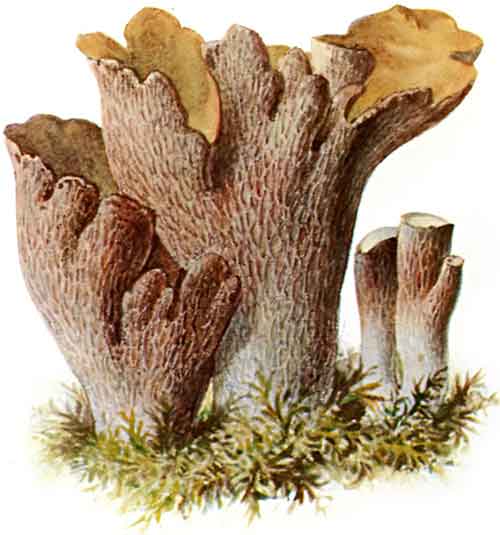Superregnum: Eukaryota
Regnum: Fungi
Subregnum: Dikarya
Divisio: Basidiomycota
Subdivisio: Agaricomycotina
Classis: Agaricomycetes
Subclassis: Phallomycetidae
Ordo: Gomphales
Familia: Gomphaceae
Genus: Gomphus
Species: G. astroites – G. brasiliensis – G. brunneus – G. cavipes – G. clavatus – G. columellus – G. conicus – G. crassipes – G. ludovicianus – G. matijun – G. megasporus – G. ochraceus – G. orientalis – G. pezizoides – G. szechwanensis – G. thiersii – G. zamorinorum
Name
Gomphus Pers., Tent. disp. meth. fung. (Lipsiae): 74 (1797)
Synonyms
Gomphora Fr., Syst. orb. veg. (Lundae): 88 (1825)
Neurophyllum Pat. [as 'Nevrophyllum'], in Doassans & Patouillard, Revue mycol., Toulouse 8(no. 29): 26 (adnot.), 27 (1886)
References
Primary references
Persoon, C.H. 1797. Tentamen dispositionis methodicae fungorum in classes, ordines genera et familias. Cum supplemento adjecto.. IV + 76 pp., 4 pl. Lipsiae. Biblioteca Digital Reference page.
Vernacular names
русский: Гомфус

Gomphus clavatus
Gomphus is a genus of cantharelloid fungi in the family Gomphaceae.[1] Once presumed to be related to chanterelles, molecular study has shown them to be allied with stinkhorns and fairy clubs. The type species of the genus is the pig's ear (G. clavatus).
Christiaan Hendrik Persoon named the genus in 1797, but did not assign any species to it at the time.[2] The generic name is derived from the Greek 'γομφος' gomphos meaning 'plug' or 'large wedge-shaped nail'.[3]
Species
As of September 2023, Index Fungorum accepts 12 species of Gomphus:[4]
| Image | Name | Taxon Author | Year | Distribution |
|---|---|---|---|---|
| Gomphus brasiliensis | Corner | 1970 | South America | |
| Gomphus brunneus | (Heinem.) Corner | 1966 | Mexico | |
| Gomphus cavipes | Corner | 1970 | South America | |
 |
Gomphus clavatus | (Pers.) Gray | 1821 | Europe, North America |
| Gomphus crassipes | (Kuntze) Maire | 1937 | Spain and North Africa | |
 |
Gomphus ludovicianus | R.H. Petersen, Justice & D.P. Lewis | 2014 | southeastern United States |
| Gomphus megasporus | Corner | 1970 | Pakistan | |
| Gomphus ochraceus | (Pat.) Singer | 1945 | ||
| Gomphus orientalis | R.H. Petersen & M. Zang | 1996 | China | |
| Gomphus szechwanensis | R.H. Petersen | 1972 | Tibet | |
| Gomphus thiersii | R.H. Petersen | 1971 | USA | |
| Gomphus yunnanensis | R.H. Petersen & M. Zang | 1996 | China |
There are several undescribed species in the forests of Myrtle beech (Nothofagus cunninghamii) in Tasmania.[5] Bruce Fuhrer noticed in 1992 that the large and ornamented spores of these species resembled those of the genera Ramaria and Beenakia.[6]
References
Giachini, Admir J.; Camelini, Carla M.; Rossi, Márcio J.; Soares, Cláudio R.F.S.; Trappe, James M. (2012). "Systematics of the Gomphales: the genus Gomphus sensu stricto". Mycotaxon. 120: 385–400. doi:10.5248/120.385.
Giachini AJ, Castellano MA (2011). "A new taxonomic classification for species in Gomphus sensu lato". Mycotaxon. 115: 183–201. doi:10.5248/115.183.
Liddell HJ, Scott R (1980). Greek-English Lexicon, Abridged Edition. Oxford University Press, Oxford, UK. ISBN 978-0-19-910207-5.
Kirk PM. "Species Fungorum (version 26th August 2015). In: Species 2000 & ITIS Catalogue of Life". Retrieved 3 September 2015.
Fuhrer B (2005) A Field Guide to Australian Fungi. Bloomings Books. ISBN 1-876473-51-7
Fuhrer B, Robinson R (1992). Rainforest Fungi of Tasmania and Southeast Australia. CSIRO Press. ISBN 978-0-643-05311-3.
Retrieved from "http://en.wikipedia.org/"
All text is available under the terms of the GNU Free Documentation License

